Prove that if (Z_{1}, Z_{2}, ldots Z_{n}) are (d)-dimensional iid standard normal random variables, [ bar{Z}=frac{1}{n} sum_{i=1}^{n}
Question:
Prove that if \(Z_{1}, Z_{2}, \ldots Z_{n}\) are \(d\)-dimensional iid standard normal random variables,
\[
\bar{Z}=\frac{1}{n} \sum_{i=1}^{n} Z_{i}, \quad S_{n}=\frac{1}{n-1} \sum_{i=1}^{n}\left(Z_{i}-\bar{Z}ight)\left(Z_{i}-\bar{Z}ight)^{T}
\]
and \(Y_{i}=S_{n}^{-1 / 2}\left(Z_{i}-\bar{Z}ight), i=1,2, \ldots, n\) is the standardized sample, \(n>d\), then
\[
E\left|Y_{1}-Y_{2}ight|>E\left|Z_{1}-Z_{2}ight|,
\]
and the ratio \(\frac{E\left|Y_{1}-Y_{2}ight|}{E\left|Z_{1}-Z_{2}ight|}\) does not depend on \(d\), only on \(n\).
Hint: In the family of \(d\)-dimensional normal samples with positive definite covariance matrices, \(\left(\bar{Z}, S_{n}ight)\) is a complete and sufficient statistic, \(\xi:=Y_{1}-\) \(Y_{2}\) is ancillary and thus by Basu's theorem \(\left(\bar{Z}, S_{n}ight)\) and \(\xi\) are independent. Introduce \(f(w):=E\left(S_{n}^{1 / 2} wight)\) where \(w \in R^{d}\). Then \(f(w)=C|w|\) where \(C\) is a constant because for arbitrary orthonormal \(d \times d\) matrix \(U\) (whose transpose is its inverse), \(U^{T} S_{n}^{1 / 2} U=\left(U^{T} S_{n} Uight)^{1 / 2}\) has the same distribution as \(S^{1 / 2}\). Thus
\[
f(U w)=E\left|S^{1 / 2} U wight|=E\left|U^{T} S_{n}^{1 / 2} U wight|=E\left|S^{1 / 2} wight|=f(w) .
\]
But then by the independence of \(\xi\) and \(S_{n}\) we have
\[
E\left|Z_{1}-Z_{2}ight|=E\left|S_{n}^{1 / 2} \xi=E f(\xi)=C Eight| \xi \mid .
\]
We just need to show that \(C<1\). Put \(w:=(1,0, \ldots, 0)^{T}\). Then \(\left|S_{n}^{1 / 2} wight|^{2}=\) \(w^{T} S_{n} w\) is a univariate empirical variance whose distribution is \(\chi_{n-1}^{2} /(n-1)\) and thus the expected value of its square root is \(C=\Gamma(n / 2) / \Gamma((n+1) / 2)<1\).
Step by Step Answer:

Cases And Materials On Employment Law
ISBN: 9780199580712
8th Edition
Authors: Richard Painter, Ann Holmes





